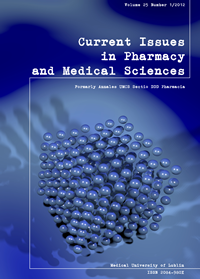Comparison of two molecular docking programs: the accuracy of ligand pose prediction
DOI:
https://doi.org/10.12923/j.2084-980X/25.1/a.08Keywords:
docking, β2 adrenergic receptors, molecular modeling, binding siteAbstract
The study was perform to compare the output of two different docking programs (Molegro Vritual Docker and AutoDock) in simulation of ligand-receptor interactions for β1 and β2 adrenergic receptors. The exactness of the predicted ligand positions was estimated on the basis of the thirteen known crystallographic structures of the ligand-receptor complexes taken from the PDB database. Significant differences in docking results obtained by using both tested programs were observed. The overall RMSD-based scoring suggests that the procedures and algorithms implemented in AutoDock lead to slightly better results.
References
1. Frielle T. et al.: Human β1- and β2-adrenergic receptors: structurally and functionally related receptors derived from distinct genes. Trends Neurosci. 321, 11, 1988.
2. Morris G.M. et al.: Automated docking using a Lamarckian genetic algorithm and empirical binding free energy function. J. Comput. Chem. 1639, 19, 1998.
3. Thomsen R. and Christensen M.H.: MolDock: a new technique for high-accuracy molecular docking. J. Med. Chem., 3315, 49, 2006.
4. Yang J.M. and Chen C.C.: GEMDOCK: a generic evolutionary method for molecular docking. Proteins, 288, 55, 2004.
Downloads
Published
Issue
Section
License
Copyright (c) 2012 Authors

This work is licensed under a Creative Commons Attribution-NonCommercial-NoDerivatives 3.0 Unported License.


